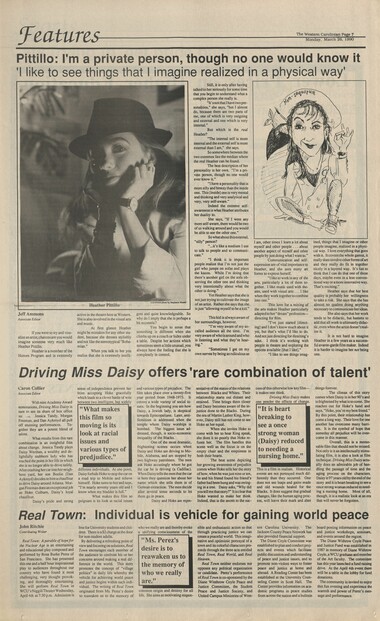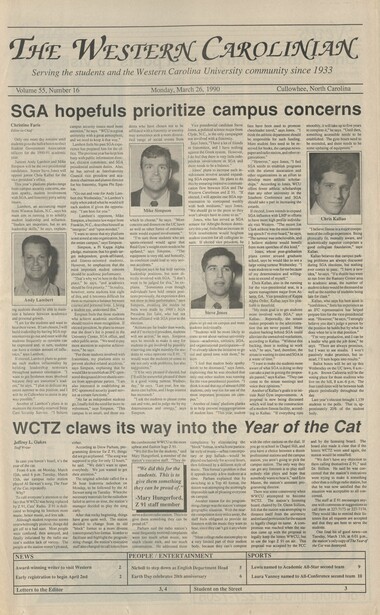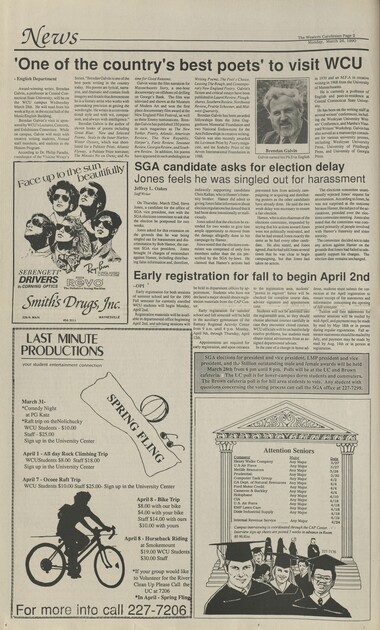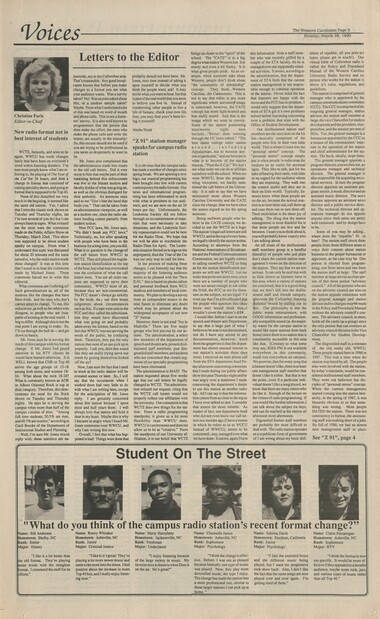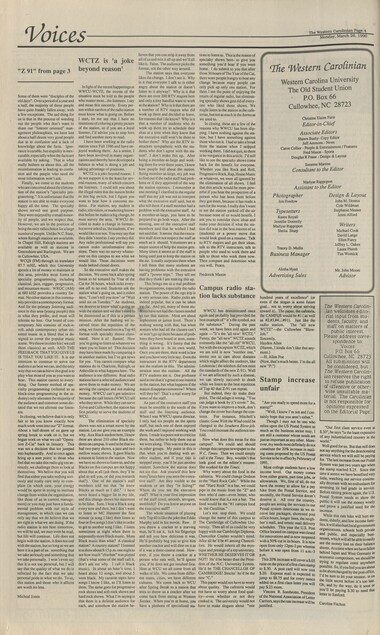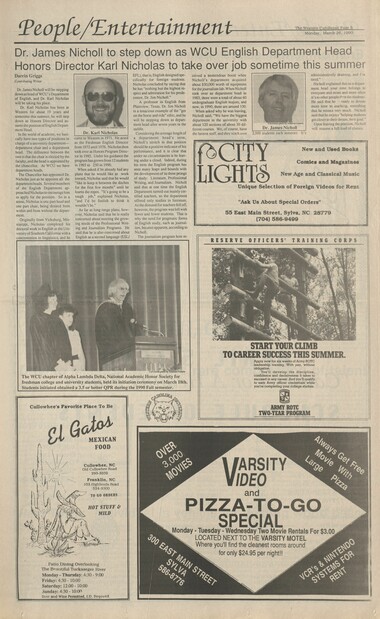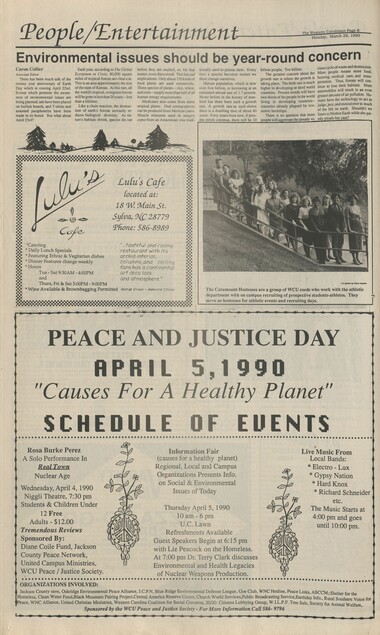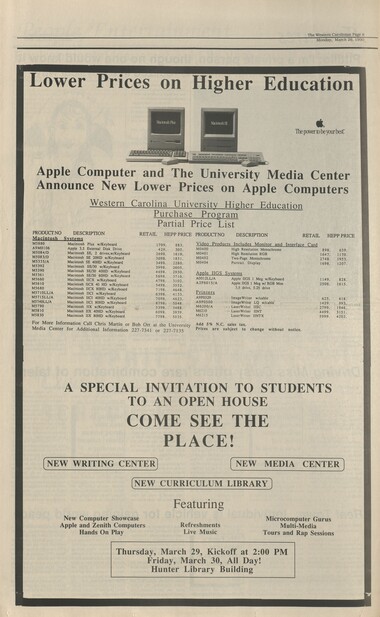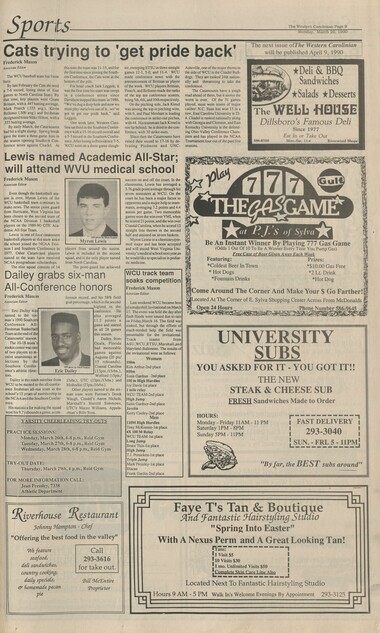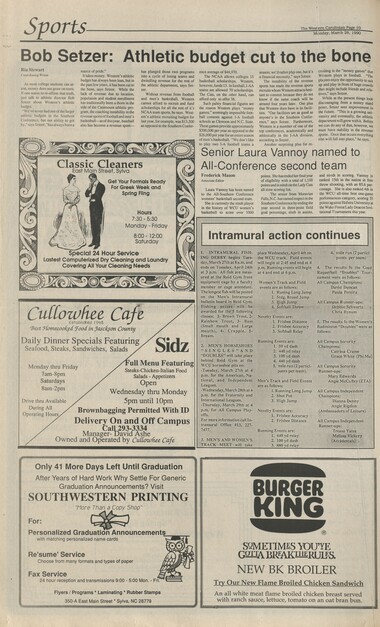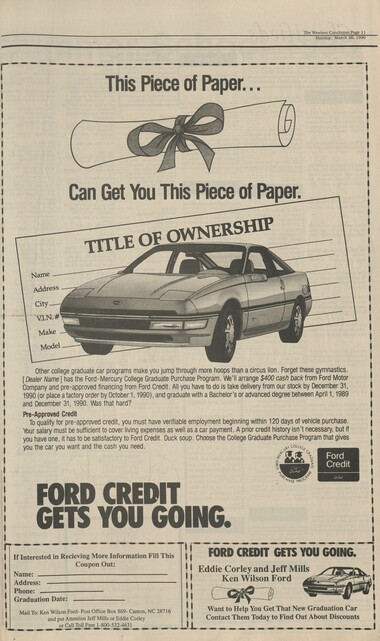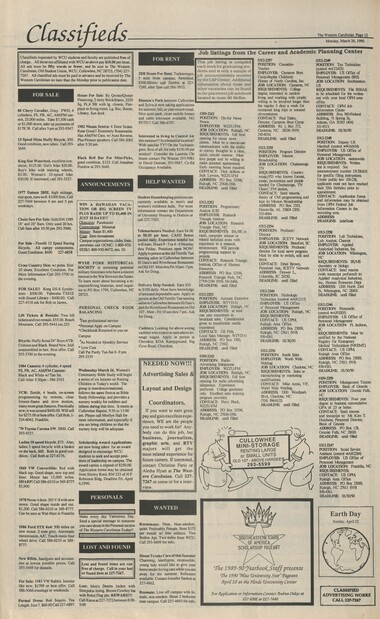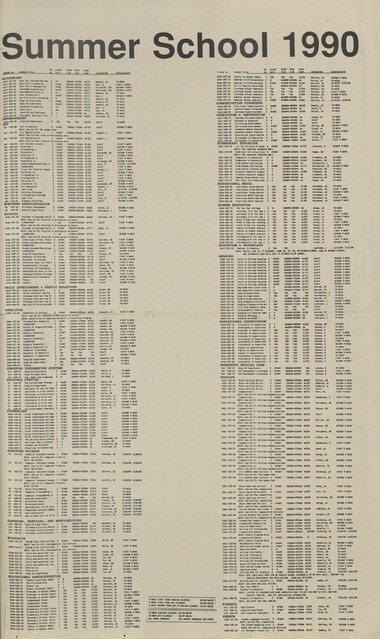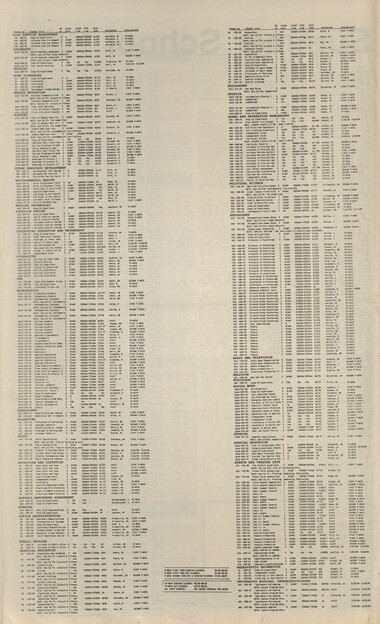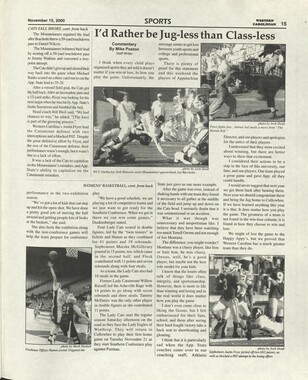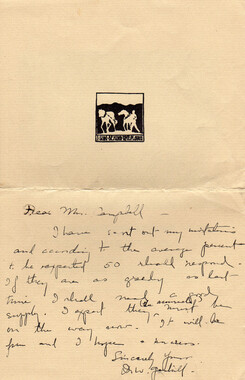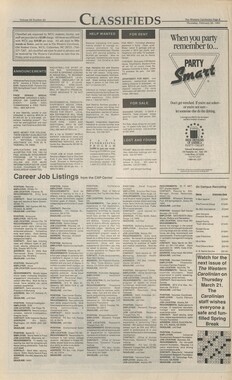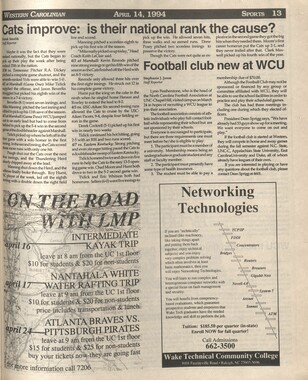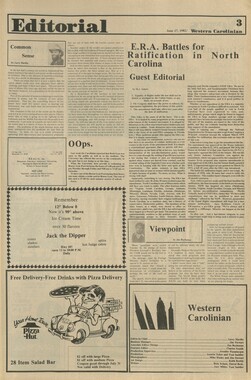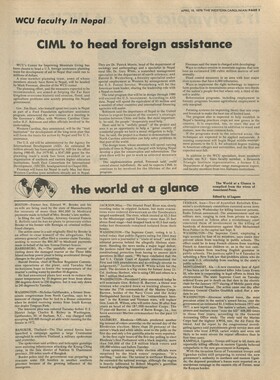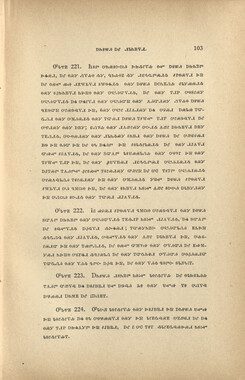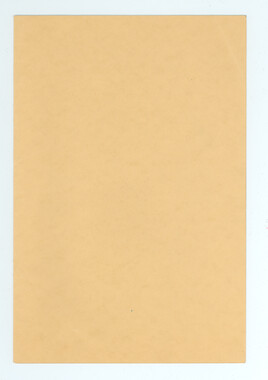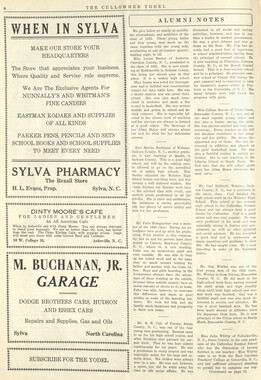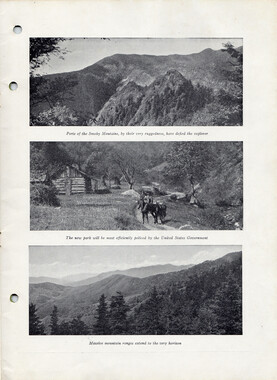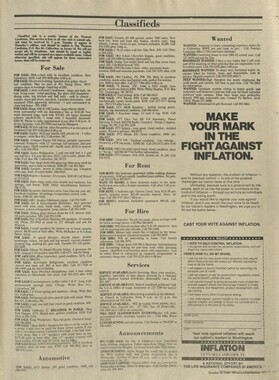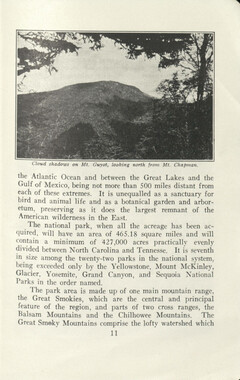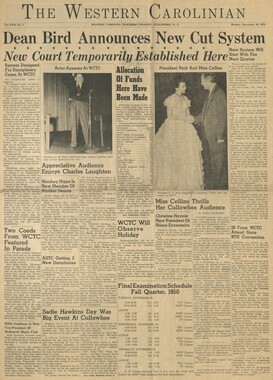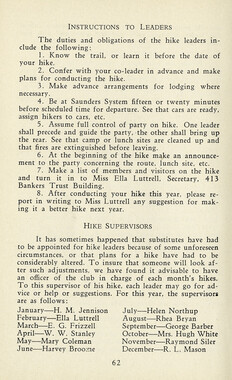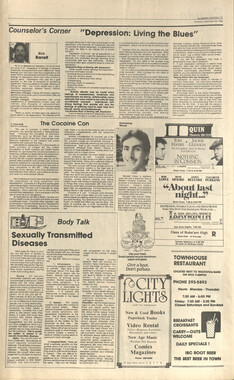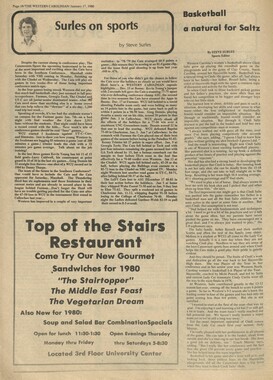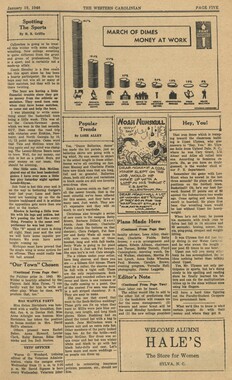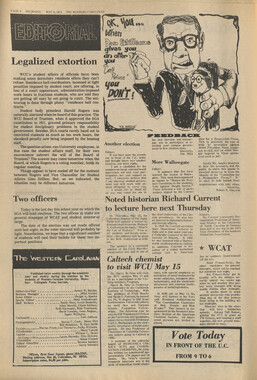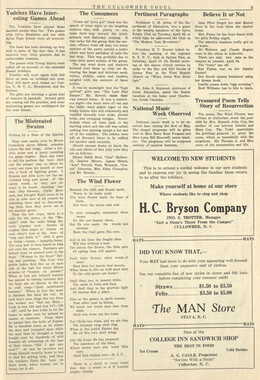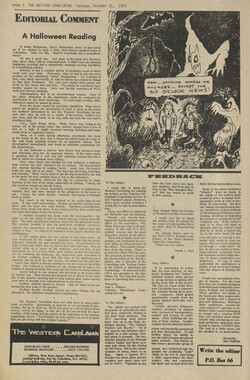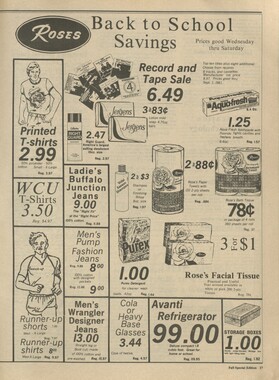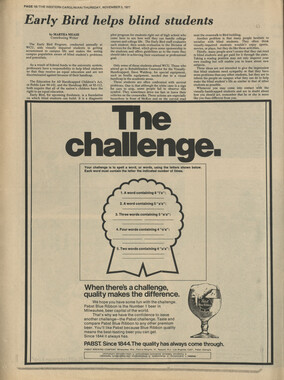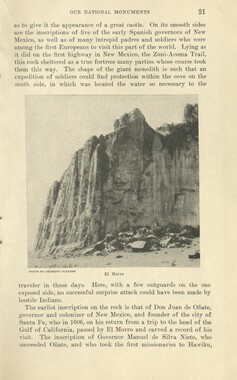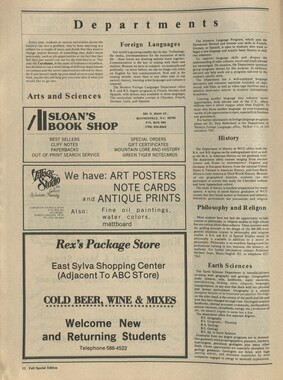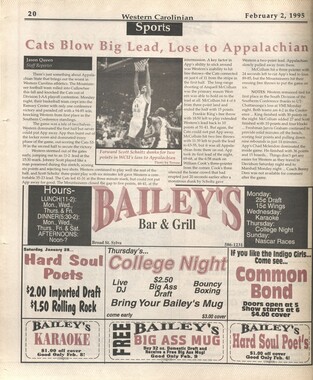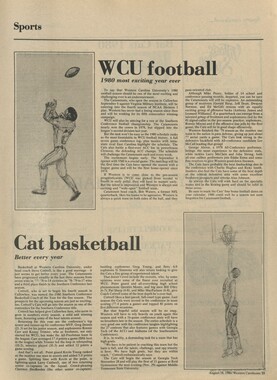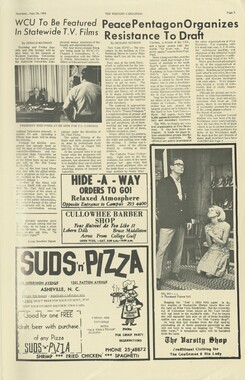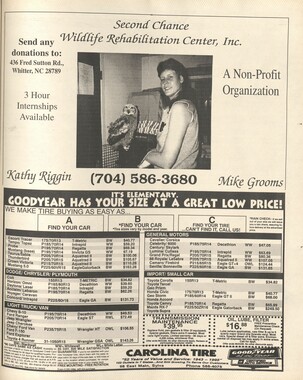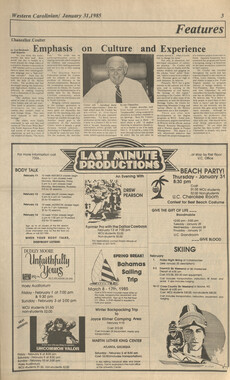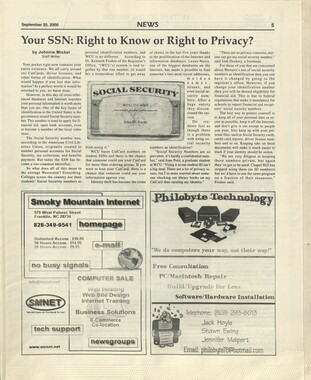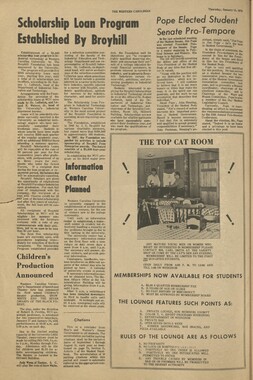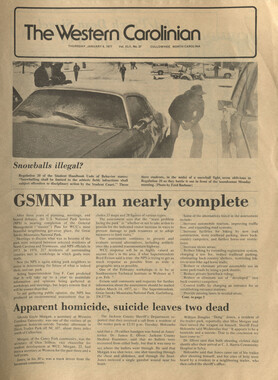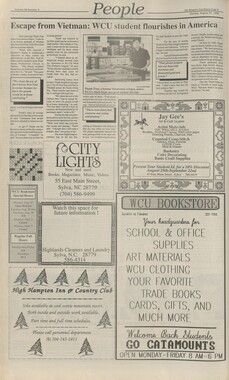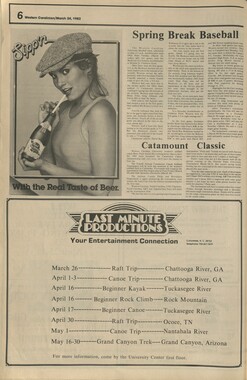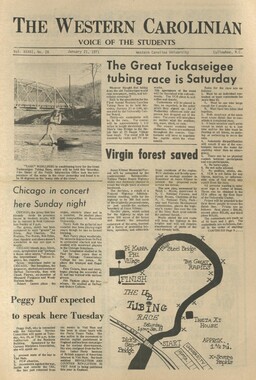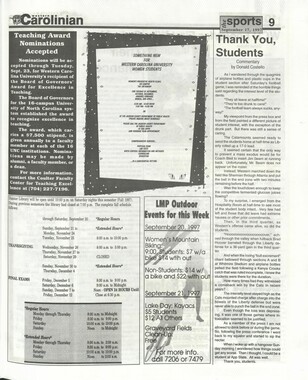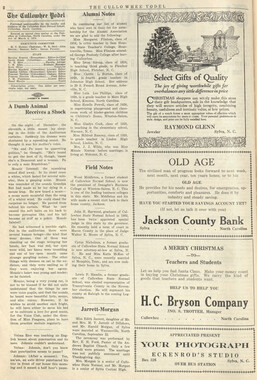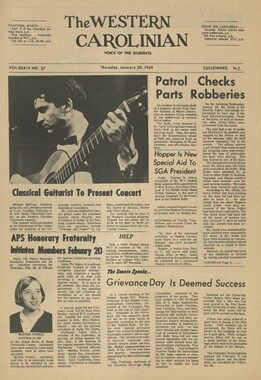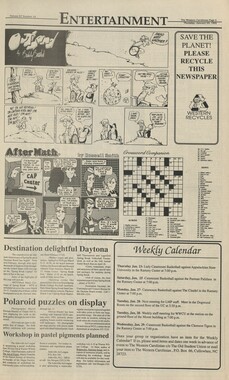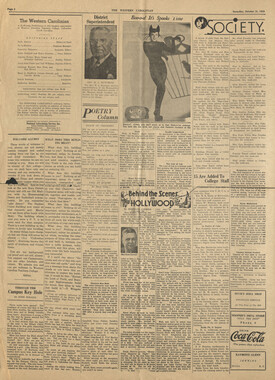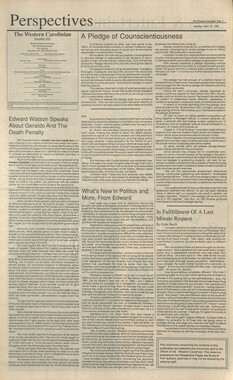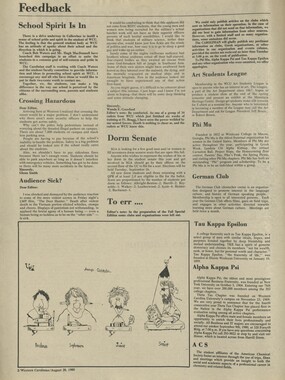Western Carolina University (20)
View all
- Canton Champion Fibre Company (2308)
- Cherokee Traditions (293)
- Civil War in Southern Appalachia (165)
- Craft Revival (1942)
- Great Smoky Mountains - A Park for America (2767)
- Highlights from Western Carolina University (430)
- Horace Kephart (941)
- Journeys Through Jackson (154)
- LGBTQIA+ Archive of Jackson County (26)
- Oral Histories of Western North Carolina (314)
- Picturing Appalachia (6772)
- Stories of Mountain Folk (413)
- Travel Western North Carolina (160)
- Western Carolina University Fine Art Museum Vitreograph Collection (129)
- Western Carolina University Herbarium (92)
- Western Carolina University: Making Memories (708)
- Western Carolina University Publications (2283)
- Western Carolina University Restricted Electronic Theses and Dissertations (146)
- Western North Carolina Regional Maps (71)
- World War II in Southern Appalachia (131)
University of North Carolina Asheville (6)
View all
- Allanstand Cottage Industries (62)
- Appalachian National Park Association (53)
- Bennett, Kelly, 1890-1974 (1388)
- Berry, Walter (76)
- Brasstown Carvers (40)
- Carver, George Washington, 1864?-1943 (26)
- Cathey, Joseph, 1803-1874 (1)
- Champion Fibre Company (233)
- Champion Paper and Fibre Company (297)
- Cherokee Indian Fair Association (16)
- Cherokee Language Program (22)
- Crowe, Amanda (40)
- Edmonston, Thomas Benton, 1842-1907 (7)
- Ensley, A. L. (Abraham Lincoln), 1865-1948 (275)
- Fromer, Irving Rhodes, 1913-1994 (70)
- George Butz (BFS 1907) (46)
- Goodrich, Frances Louisa (120)
- Grant, George Alexander, 1891-1964 (96)
- Heard, Marian Gladys (60)
- Kephart, Calvin, 1883-1969 (15)
- Kephart, Horace, 1862-1931 (313)
- Kephart, Laura, 1862-1954 (39)
- Laney, Gideon Thomas, 1889-1976 (439)
- Masa, George, 1881-1933 (61)
- McElhinney, William Julian, 1896-1953 (44)
- Niggli, Josephina, 1910-1983 (10)
- North Carolina Park Commission (105)
- Osborne, Kezia Stradley (9)
- Owens, Samuel Robert, 1918-1995 (11)
- Penland Weavers and Potters (36)
- Roberts, Vivienne (15)
- Roth, Albert, 1890-1974 (142)
- Schenck, Carl Alwin, 1868-1955 (1)
- Sherrill's Photography Studio (2565)
- Southern Highland Handicraft Guild (127)
- Southern Highlanders, Inc. (71)
- Stalcup, Jesse Bryson (46)
- Stearns, I. K. (213)
- Thompson, James Edward, 1880-1976 (226)
- United States. Indian Arts and Crafts Board (130)
- USFS (683)
- Vance, Zebulon Baird, 1830-1894 (1)
- Weaver, Zebulon, 1872-1948 (58)
- Western Carolina College (230)
- Western Carolina Teachers College (282)
- Western Carolina University (1794)
- Western Carolina University. Mountain Heritage Center (18)
- Whitman, Walt, 1819-1892 (10)
- Wilburn, Hiram Coleman, 1880-1967 (73)
- Williams, Isadora (3)
- Cain, Doreyl Ammons (0)
- Crittenden, Lorraine (0)
- Rhodes, Judy (0)
- Smith, Edward Clark (0)
- Appalachian Region, Southern (2399)
- Asheville (N.C.) (1917)
- Avery County (N.C.) (26)
- Blount County (Tenn.) (161)
- Buncombe County (N.C.) (1671)
- Cherokee County (N.C.) (283)
- Clay County (N.C.) (555)
- Graham County (N.C.) (233)
- Great Smoky Mountains National Park (N.C. and Tenn.) (510)
- Haywood County (N.C.) (3522)
- Henderson County (N.C.) (70)
- Jackson County (N.C.) (4692)
- Knox County (Tenn.) (25)
- Knoxville (Tenn.) (12)
- Lake Santeetlah (N.C.) (10)
- Macon County (N.C.) (420)
- Madison County (N.C.) (211)
- McDowell County (N.C.) (39)
- Mitchell County (N.C.) (132)
- Polk County (N.C.) (35)
- Qualla Boundary (981)
- Rutherford County (N.C.) (76)
- Swain County (N.C.) (2113)
- Transylvania County (N.C.) (247)
- Watauga County (N.C.) (12)
- Waynesville (N.C.) (73)
- Yancey County (N.C.) (72)
- Aerial Photographs (3)
- Aerial Views (60)
- Albums (books) (4)
- Articles (1)
- Artifacts (object Genre) (228)
- Bibliographies (1)
- Biography (general Genre) (2)
- Cards (information Artifacts) (38)
- Clippings (information Artifacts) (191)
- Crafts (art Genres) (622)
- Depictions (visual Works) (21)
- Design Drawings (1)
- Drawings (visual Works) (184)
- Envelopes (73)
- Facsimiles (reproductions) (1)
- Fiction (general Genre) (4)
- Financial Records (12)
- Fliers (printed Matter) (67)
- Glass Plate Negatives (381)
- Guidebooks (2)
- Internegatives (10)
- Interviews (812)
- Land Surveys (102)
- Letters (correspondence) (1013)
- Manuscripts (documents) (619)
- Maps (documents) (177)
- Memorandums (25)
- Minutes (administrative Records) (59)
- Negatives (photographs) (5835)
- Newsletters (1285)
- Newspapers (2)
- Occupation Currency (1)
- Paintings (visual Works) (1)
- Pen And Ink Drawings (1)
- Periodicals (193)
- Personal Narratives (10)
- Photographs (12976)
- Plans (maps) (1)
- Poetry (7)
- Portraits (1960)
- Postcards (329)
- Programs (documents) (151)
- Publications (documents) (2237)
- Questionnaires (65)
- Scrapbooks (282)
- Sheet Music (2)
- Slides (photographs) (402)
- Songs (musical Compositions) (2)
- Sound Recordings (796)
- Specimens (92)
- Speeches (documents) (15)
- Tintypes (photographs) (8)
- Transcripts (322)
- Video Recordings (physical Artifacts) (23)
- Vitreographs (129)
- Text Messages (0)
- A.L. Ensley Collection (275)
- Appalachian Industrial School Records (7)
- Appalachian National Park Association Records (336)
- Axley-Meroney Collection (2)
- Bayard Wootten Photograph Collection (20)
- Bethel Rural Community Organization Collection (7)
- Blumer Collection (5)
- C.W. Slagle Collection (20)
- Canton Area Historical Museum (2110)
- Carlos C. Campbell Collection (282)
- Cataloochee History Project (65)
- Cherokee Studies Collection (4)
- Daisy Dame Photograph Album (5)
- Daniel Boone VI Collection (1)
- Doris Ulmann Photograph Collection (112)
- Elizabeth H. Lasley Collection (1)
- Elizabeth Woolworth Szold Fleharty Collection (4)
- Frank Fry Collection (95)
- George Masa Collection (173)
- Gideon Laney Collection (452)
- Hazel Scarborough Collection (2)
- Hiram C. Wilburn Papers (28)
- Historic Photographs Collection (236)
- Horace Kephart Collection (861)
- Humbard Collection (33)
- Hunter and Weaver Families Collection (1)
- I. D. Blumenthal Collection (4)
- Isadora Williams Collection (4)
- Jesse Bryson Stalcup Collection (47)
- Jim Thompson Collection (224)
- John B. Battle Collection (7)
- John C. Campbell Folk School Records (80)
- John Parris Collection (6)
- Judaculla Rock project (2)
- Kelly Bennett Collection (1407)
- Love Family Papers (11)
- Major Wiley Parris Civil War Letters (3)
- Map Collection (12)
- McFee-Misemer Civil War Letters (34)
- Mountain Heritage Center Collection (4)
- Norburn - Robertson - Thomson Families Collection (44)
- Pauline Hood Collection (7)
- Pre-Guild Collection (2)
- Qualla Arts and Crafts Mutual Collection (12)
- R.A. Romanes Collection (681)
- Rosser H. Taylor Collection (1)
- Samuel Robert Owens Collection (94)
- Sara Madison Collection (144)
- Sherrill Studio Photo Collection (2558)
- Smoky Mountains Hiking Club Collection (616)
- Stories of Mountain Folk - Radio Programs (374)
- The Reporter, Western Carolina University (510)
- Venoy and Elizabeth Reed Collection (16)
- WCU Gender and Sexuality Oral History Project (32)
- WCU Mountain Heritage Center Oral Histories (25)
- WCU Oral History Collection - Mountain People, Mountain Lives (71)
- WCU Students Newspapers Collection (1744)
- Western North Carolina Tomorrow Black Oral History Project (69)
- William Williams Stringfield Collection (2)
- Zebulon Weaver Collection (109)
- African Americans (390)
- Appalachian Trail (35)
- Artisans (521)
- Cherokee art (84)
- Cherokee artists -- North Carolina (10)
- Cherokee language (21)
- Cherokee pottery (101)
- Cherokee women (208)
- Church buildings (167)
- Civilian Conservation Corps (U.S.) (110)
- College student newspapers and periodicals (1830)
- Dams (103)
- Dance (1023)
- Education (222)
- Floods (61)
- Folk music (1015)
- Forced removal, 1813-1903 (2)
- Forest conservation (220)
- Forests and forestry (921)
- Gender nonconformity (4)
- Great Smoky Mountains National Park (N.C. and Tenn.) (181)
- Hunting (38)
- Landscape photography (10)
- Logging (103)
- Maps (84)
- Mines and mineral resources (8)
- North Carolina -- Maps (18)
- Paper industry (38)
- Postcards (255)
- Pottery (135)
- Railroad trains (71)
- Rural electrification -- North Carolina, Western (3)
- School integration -- Southern States (2)
- Segregation -- North Carolina, Western (5)
- Slavery (5)
- Sports (452)
- Storytelling (245)
- Waterfalls -- Great Smoky Mountains (N.C. and Tenn.) (66)
- Weaving -- Appalachian Region, Southern (280)
- Wood-carving -- Appalachian Region, Southern (328)
- World War, 1939-1945 (173)
Western Carolinian Volume 55 Number 16
Item
Item’s are ‘child’ level descriptions to ‘parent’ objects, (e.g. one page of a whole book).
-
-
features The Western Carolinian Page 7 Monday, March 26, 1990 Pittillo: I'm a private person, though no one would know it like to see things that I imagine realized in a physical way' " ;■ ■ . ■ -■ ■ .- Heather Pittillo -Carolinian photo by Stephanie Mettcr Jeff Ammons Associate Editor If you were to try and visualize an artist, chances are you would imagine someone very much like Heather Pittillo. Heather is a member of the Honors Program and is extremely active in the theatre here at Western. She is also involved in the visual arts and music. At first glance Heather might be mistaken for any other student, because she dresses stylishly and not like the stereotypical "Bohemian." When you talk to her you realize that she is extremely intelli gent and quite knowledgeable. So why do I imply that she is perhaps a bit eccentric? You begin to sense that something is different when she climbs up on a couch or hides under a table. Despite her actions which sometimes seem a little unusual, you always have the feeling that she is completely in control. Still, it is only after having talked to her seriously for some time that you begin to understand what a complex person she really is. "It' s not that I have two personalities," she says, "but I almost do, because there are two parts of me, one of which is very outgoing and external and one which is very internal." But which is the real Heather? "The internal self is more internal and the external self is more external than I am," she says. So somewhere between the two extremes lies the median where the real Heather can be found. The best description of her personality is her own. "I'm a private person, though no one would ever know it." "I have a personality that is more silly and breezy than the inside one. This [inside] one is very mental and thinking and very analytical and very, very self-aware." Indeed the extreme self- awareness is what Heather attributes her duality to. She says, "If I were any more self-aware, there would be two of us walking around and you would be able to see the other one." So what about this external, "silly" person? "...it's like a medium I use to talk to people and to communicate." "I think it is important people realize that I'm not just the girl who jumps on sofas and plays the kazoo. While I'm doing that there's another girl on the sofa observing the other one and thinking very intentionally about what the other is doing." Yet Heather says that she is not just trying to cultivate the image of an artist. Rather she says that she is just "allowing myself to be a kid." This kid is always aware of her surroundings, however. "I'm very aware of my so- called audience all the time. I'm very aware of who is around and who is listening and what they're hearing." "Sometimes I get on my own nerves by being as ridiculous as I am, other times I learn a lot about myself and other people . .. about another aspect of myself and other people by just doing what I want to." Communication and self- expression are of vital importance to Heather, and she uses many art forms to express herself. "I like to work in any of the arts, particularly a lot of them together. I like music used with theatre, used with visual arts ... I like when they work together to combine into one." This love for a mixing of the arts makes Heather particularly adapted to her "dream" profession— directing for film. "I've just started [directing] and I don't know much about it yet, but that's what I'd like to do. And not just directing for directing's sake. I think it's working with people in theatre and exploring the options available [that I like]." "I like to see things imag ined, things that I imagine or other people imagine, realized in a physical way. I love everything that goes with it. It covers the whole gamut, it really does involve other forms of art and they really do fit in together nicely in a layered way. It's fun to think that I can do that one of these days, maybe even in a less conventional way or a more innovative way. That's exciting." Heather says that her best quality is probably her willingness to take a risk. She says that she has almost no qualms doing anything necessary to communicate her ideas. She also says that her work tends to be didactic, but hastens to add that all work is ultimately didactic, even when the artist doesn't realize it. It is not hard to imagine Heather in a few years as a successful avante-garde film maker. Indeed it is harder to imagine her not being one. Driving Miss Daisy offers 'rare combination of talent' Caron Collier Associate Editor With nine Academy Award nominations, Driving Miss Daisy is sure to see its share of box office sue ...»$. Jessica Tandy, Morgan Freeman, and Dan Aykroyd all pull off stunning performances. Together they are a potent blend of talent. What results from this rare combination is an insightful film about change. Jessica Tandy plays Daisy Werthan, a wealthy and delightfully stubborn lady who has reached the point in her life in which she is no longer able to drive safely. After crashing her car into her neighbors yard, her son Boolie (Dan Aykroyd) decides to hire a chauffeur to drive Daisy around Atlanta. Morgan Freeman does an exceptional job as Hoke Colburn, Daisy's loyal chauffeur. Daisy's pride and strong sense of independence prevent her from accepting Hoke gracefully which leads to a clever battle of wits between two intelligent, but widely "What makes this film so moving is its look at racial issues and various types of predjudice." different individuals. At one point, Daisy forbids Hoke to stop the car on a road trip to Mobile and relieve himself. Hoke turns to her and says, "I'm nearly seventy years old and I know when my bladder is full." What makes this film so poignant is its look at racial issues and various types of prejudice. The film takes place over a twenty-five year period from 1948-1973. It covers a wide variety of social issues. In the beginning you see how Daisy, a Jewish lady, is skeptical towards Episcopalians. Later, anti- Semitism is addressed when the temple where Daisy worships is bombed. The biggest issue addressed, though, is socio-economic inequality of the Blacks. One of the most dramatic, frightening scenes occurs when Daisy and Hoke are driving to Mobile, Alabama, and are stopped by two highway patrolmen. The men ask Hoke accusingly where he got the car he is driving (a Cadillac). When Daisy tells the men that the car is hers they question her about her name which she tells them is of German extraction. The men decide after several tense seconds to let them go in peace. Daisy and Hoke are repre sentative of the status of the relations between Blacks and Whites. Their relationship starts out distant and strained. Time brings them closer and Daisy becomes aware of the injustice done to the Blacks. During the era of Martin Luther King, however, Daisy still has not come to see Hoke as her equal. When she invites Hoke to come with her to hear King speak, she does it so poorly that Hoke refuses her. The film handles this scene well as the focus is on the empty chair and the emptiness in both their hearts. The best scene depicting her growing awareness of prejudice comes when Hoke tells her the story of how, when he was just nine or ten, he and his friend found his friend's father had been hung and was swinging in a tree. Daisy asks, "Why did you tell me that story?" It is clear that Hoke wanted to make her think. Indeed, that is the secret to the suc cess of this otherwise low key film— it makes one think. Driving Miss Daisy makes one ponder the effects of change. "It is heart breaking to see a once strong woman (Daisy) reduced to needing a nursing home." This is a film in realism. Historical events are not portrayed much differently than they occurred. One does not see leaps and gains made and old wounds healed for the Blacks. It does suggest that gradual changes, like the human aging process, will leave their mark and alter things forever. The climax of this story comes when Daisy is in her 90's and is frightened by what is to come. She reaches out for Hoke's hand and says, "Hoke, you're my best friend." By this point, their relationship has come a long way. Their love for one another has overcome many barriers. It is the symbol of hope that someday all prejudice will be overcome in this manner. Overall, this is a memorable film that should not be missed. Not only is it an intellectually stimulating film, it is also a look at film technique. Driving Miss Daisy actually does an admirable job of handling the passage of time and the aging process on the characters. Daisy is 97 years old by the end of the story and it is heart breaking to see a once strong woman reduced to needing a nursing home. Most of all, though, it is a realistic look at an era that will never be forgotten. Real Town: Individual is vehicle for gaining world peace John Ritchie Contributing Writer Real Town: A parable of hope for the Nuclear Age is an entertaining and educational play composed and performed by Rosa Burke Perez of San Francisco. She has presented this one and a half hour inspirational play to audiences throughout our country who have found it most challenging, very thought provoking, and thoroughly entertaining. She will perform Real Town in WCU's Niggili Theater Wednesday, April 4th at 7:30 p.m. Admission is free for University students and children . There is a $2 charge at the door for non-student adults. By delivering a refreshing point of view and focusing on solutions, Real Town encourages each member of the audience to confront his or her concerns around making a real difference in the world. This story promotes the concept of "village politics" in daily life whereby the vehicle for achieving world peace and justice begins within each individual. The writing of Real Town originated from Ms. Perez's desire to reawaken us to the memory of who we really are and thereby evoke a unifying consciousness of the "Ms. Perez's desire is to reawaken us to the memory of who we really are. tt common origin and destiny for all life. She aims at motivating respon sible and enthusiastic action so that through practicing justice we can create a peaceful world. This imaginative and optimistic portrayal of a town and its colorful characters proceeds through the three acts entitled Real Town, Real World, and Real Heaven. Real Town neither endorses nor opposes any political organization or candidate. Perez's performance of Real Town is co-sponsored by the Diane Winthrow Coyle Peace and Justice Committee, the Student Peace and Justice Society, and United Campus Ministries of West ern Carolina University. The Jackson County Peace Network has also provided financial support. The Diane Coyle Committee was established to plan and conduct projects and events which facilitate public discussion and understanding of peace and justice issues, and to promote non-violent ways to foster peace and justice at home and abroad. A Reading Center has been established at the University Counseling Center in Scott Hall. The Center provides information on academic programs in peace studies from across the nation and a bulletin board posting information on peace and justice workshops, seminars, and events around the region. The Diane Withrow Coyle Peace and Justice Fund was established in 1987 in memory of Diane Withrow Coyle, a WCU graduate and member of the Art faculty. The committee has this year launched a fund raising drive. At the April 4th event there will be a table in the lobby for fund donations. The community is invited to enjoy this fun evening and experience the warmth and power of Perez's message and performance. '
Object
Object’s are ‘parent’ level descriptions to ‘children’ items, (e.g. a book with pages).
-
The Western Carolinian is Western Carolina University's student-run newspaper. The paper was published as the Cullowhee Yodel from 1924 to 1931 before changing its name to The Western Carolinian in 1933.
-
